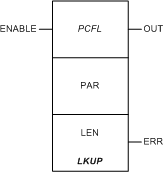|
|
(Original Document)
|
|
Name in LL984 Editor
|
Function Block Name
|
|---|---|
|
name of legacy 984 instruction
|
name in other tools and editors like:
|
 |
 |
|
x
|
y
|
|---|---|
|
10.0
|
1.0
|
|
20.0
|
2.0
|
|
30.0
|
3.0
|
|
30.0
|
3.5
|
|
40.0
|
4.0
|

|
Input Pin
|
Name
|
Data Type
|
Address Range
|
Meaning
|
|---|---|---|---|---|
|
Top
|
ENABLE
|
–
|
ON = enables process control function
|
|
Node
|
Node Type
|
Name
|
Data Type
|
Address Range
|
Meaning
|
|---|---|---|---|---|---|
|
Middle
|
IN/OUT
|
PAR
|
ARRAY[1...39] OF UINT
|
%MW
|
see Parameter PAR below
|
|
Bottom
|
IN
|
LEN
|
UINT
|
39
|
length of parameter block (can not be changed)
|
|
Output Pin
|
Name
|
Data Type
|
Address Range
|
Meaning
|
|---|---|---|---|---|
|
Top
|
OUT
|
BOOL
|
–
|
ON = operation successful
|
|
Bottom
|
ERR
|
BOOL
|
–
|
ON = operation not successful
|
|
Word
|
Content
|
Format
|
|---|---|---|
|
1, 2
|
input
|
REAL (Floating Point)
|
|
3
|
output status
|
UINT
|
|
4
|
input status
|
UINT
|
|
5
|
number of point pairs
|
UINT
|
|
6, 7
|
point x1
|
REAL (Floating Point)
|
|
8, 9
|
point y1
|
REAL (Floating Point)
|
|
10, 11
|
point x2
|
REAL (Floating Point)
|
|
12, 13
|
point y2
|
REAL (Floating Point)
|
|
...
|
...
|
...
|
|
34, 35
|
point x8
|
REAL (Floating Point)
|
|
36, 37
|
point y8
|
REAL (Floating Point)
|
|
38, 39
|
output
|
REAL (Floating Point)
|
|
Control Expert-IEC bits
|
Function
|
|---|---|
|
0...4
|
standard output bits (flags)
|
|
5
|
1 = invalid number of points
|
|
6
|
1 = input clamped, i.e. out of table’s range
|
|
7...15
|
not used
|
|
Control Expert-IEC bits
|
Function
|
|---|---|
|
0...11
|
not used
|
|
12...15
|
standard input bits (flags)
|